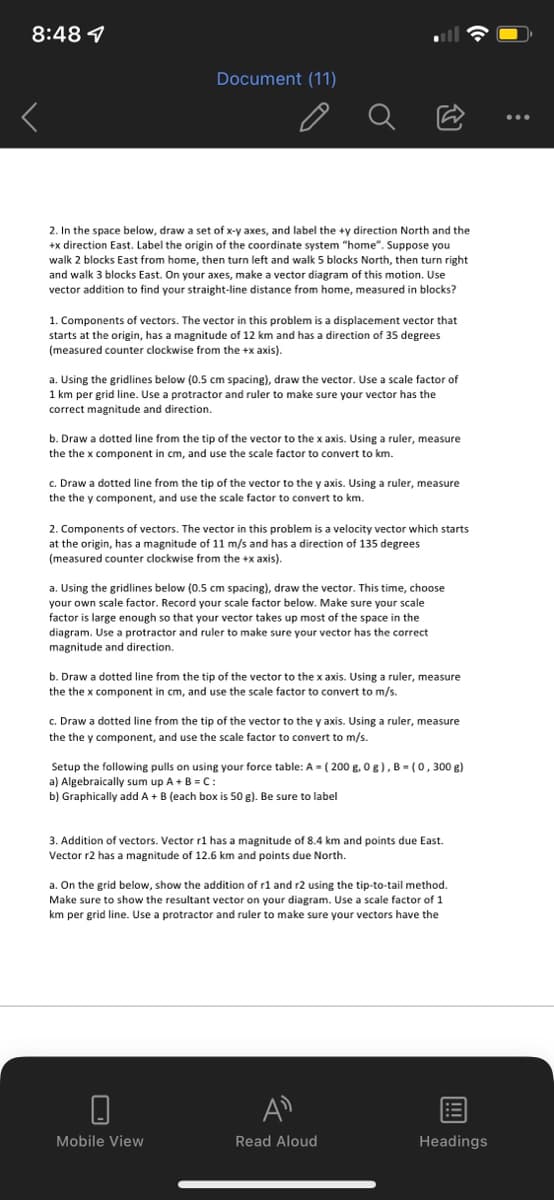2. In the space below, draw a set of x-y axes, and label the +y direction North and the +x direction East. Label the origin of the coordinate system "home". Suppose you walk 2 blocks East from home, then turn left and walk 5 blocks North, then turn right and walk 3 blocks East. On your axes, make a vector diagram of this motion. Use vector addition to find your straight-line distance from home, measured in blocks?
2. In the space below, draw a set of x-y axes, and label the +y direction North and the +x direction East. Label the origin of the coordinate system "home". Suppose you walk 2 blocks East from home, then turn left and walk 5 blocks North, then turn right and walk 3 blocks East. On your axes, make a vector diagram of this motion. Use vector addition to find your straight-line distance from home, measured in blocks?
Physics for Scientists and Engineers: Foundations and Connections
1st Edition
ISBN:9781133939146
Author:Katz, Debora M.
Publisher:Katz, Debora M.
Chapter3: Vectors
Section: Chapter Questions
Problem 20PQ
Related questions
Question

Transcribed Image Text:8:48 4
Document (11)
2. In the space below, draw a set of x-y axes, and label the +y direction North and the
+x direction East. Label the origin of the coordinate system "home". Suppose you
walk 2 blocks East from home, then turn left and walk 5 blocks North, then turn right
and walk 3 blocks East. On your axes, make a vector diagram of this motion. Use
vector addition to find your straight-line distance from home, measured in blocks?
1. Components of vectors. The vector in this problem is a displacement vector that
starts at the origin, has a magnitude of 12 km and has a direction of 35 degrees
(measured counter clockwise from the +x axis).
a
a. Using the gridlines below (0.5 cm spacing), draw the vector. Use a scale factor of
1 km per grid line. Use a protractor and ruler to make sure your vector has the
correct magnitude and direction.
b. Draw a dotted line from the tip of the vector to the x axis. Using a ruler, measure
the the x component in cm, and use the scale factor to convert to km.
c. Draw a dotted line from the tip of the vector to the y axis. Using a ruler, measure
the the y component, and use the scale factor to convert to km.
2. Components of vectors. The vector in this problem is a velocity vector which starts
at the origin, has a magnitude of 11 m/s and has a direction of 135 degrees
(measured counter clockwise from the +x axis).
a. Using the gridlines below (0.5 cm spacing), draw the vector. This time, choose
your own scale factor. Record your scale factor below. Make sure your scale
factor is large enough so that your vector takes up most of the space in the
diagram. Use a protractor and ruler to make sure your vector has the correct
magnitude and direction.
b. Draw a dotted line from the tip of the vector to the x axis. Using a ruler, measure
the the x component in cm, and use the scale factor to convert to m/s.
c. Draw a dotted line from the tip of the vector to the y axis. Using a ruler, measure
the the y component, and use the scale factor to convert to m/s.
Setup the following pulls on using your force table: A = (200 g, 0 g), B = (0, 300 g)
a) Algebraically sum up A + B = C:
b) Graphically add A + B (each box is 50 g). Be sure to label
3. Addition of vectors. Vector r1 has a magnitude of 8.4 km and points due East.
Vector r2 has a magnitude of 12.6 km and points due North.
0
a. On the grid below, show the addition of r1 and r2 using the tip-to-tail method.
Make sure to show the resultant vector on your diagram. Use a scale factor of 1
km per grid line. Use a protractor and ruler to make sure your vectors have the
Mobile View
AD
Read Aloud
!!!
Headings
:
Expert Solution
This question has been solved!
Explore an expertly crafted, step-by-step solution for a thorough understanding of key concepts.
Step by step
Solved in 3 steps with 3 images

Knowledge Booster
Learn more about
Need a deep-dive on the concept behind this application? Look no further. Learn more about this topic, physics and related others by exploring similar questions and additional content below.Recommended textbooks for you

Physics for Scientists and Engineers: Foundations…
Physics
ISBN:
9781133939146
Author:
Katz, Debora M.
Publisher:
Cengage Learning

Principles of Physics: A Calculus-Based Text
Physics
ISBN:
9781133104261
Author:
Raymond A. Serway, John W. Jewett
Publisher:
Cengage Learning

Physics for Scientists and Engineers: Foundations…
Physics
ISBN:
9781133939146
Author:
Katz, Debora M.
Publisher:
Cengage Learning

Principles of Physics: A Calculus-Based Text
Physics
ISBN:
9781133104261
Author:
Raymond A. Serway, John W. Jewett
Publisher:
Cengage Learning